Your Cart is Empty

31 facts you wish you didn’t know about plastic waste
Look around you, how much plastic can you see right now?
Chances are your drinking from a coffee cup which might be plastic coated, using a plastic phone case. Even the pen on your desk is almost certainly plastic.
Plastic today really does make the world go around.
However, over the coming years things will have to change.
Thanks to things like the "David Attenborough effect", many people are starting to really understand the impact of plastic waste and have been influenced to make a change.
Governments are banning single use plastics around the world, and many companies are trying to pre-empt this by introducing bans themselves such as Guinness banning any plastic from their packaging.

Shops from Iceland to Ikea are making moves to drastically reduce their disposable plastics over the coming years. Meanwhile, Kenya has imposed the toughest plastic bag ban yet, charging up to $38,000 or 4 years in jail for using them.

1. A report in the Guardian has estimated that 8.3 billion tons of plastic have been produced since the 1950s, the equivalent in weight of more than 800,000 Eiffel Towers.
2. Only about 30% of plastic ever produced is still in use. The remainder has been disposed of...
3. The 70% of plastic waste that has been disposed of can be broken down as follows: 79% is either in landfills or in the environment, 12% has been incinerated and 9% has been recycled

4. Attempting to recycle plastic might not be as sustainable as you once thought. Many rich countries have been sending their plastic waste to poorer countries where it will likely end up in landfills instead of being recycled.
5. Plastic takes thousands of years to decompose. In the process, it breaks down into thousands of microplastics that can be ingested and enter the food cycle.
6. If you build separate systems for plastic recycling, that’s additional pollution caused in the construction, transportation, cleaning and filtering of waste.
7. The level of plastic used is increasing unabated. Half of all plastic made since 1950 was produced in the last 13 years.
8. One geological indicator of the Anthropocene (the new geological period we are in, as indicated by modern man’s impact on a changing environment) will be the levels of waste in the ground.
9. Plastic can now be found on every beach in the world, from busy tourist beaches to isolated island paradise’s.
10. The world’s population of 2.5 billion produced 1.5 million tonnes of plastic in 1950. Today this figure is over 320 million tonnes, and is set to double by 2034.
11. By 2050, there will likely be more plastic in the sea than fish if we carry on at our current trajectory.
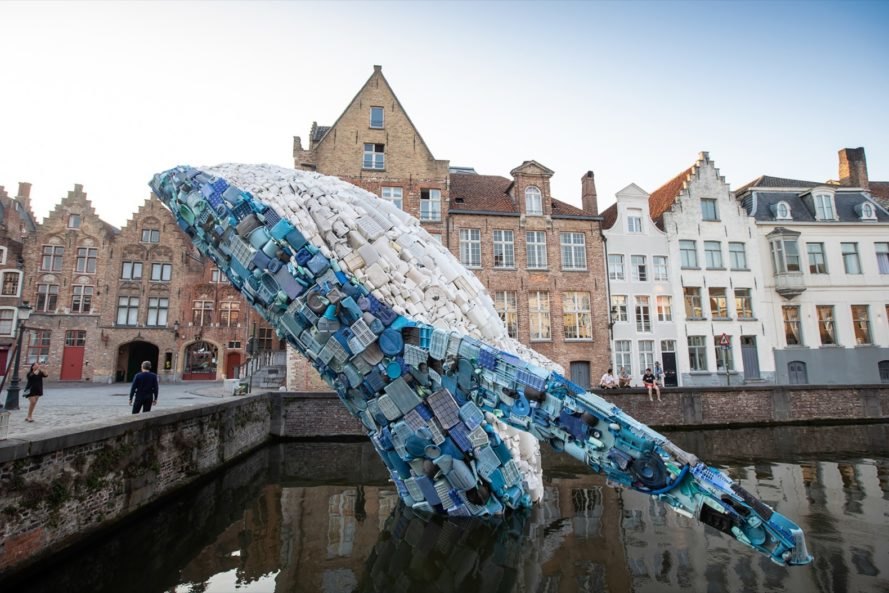
Above: Plastic waste sculture in Bruges, made from 5 tonnes of plastic pulled from the oceans
12. Every day around 8 million pieces of plastic finds its way into our oceans.
14. Of this 5.25 trillion tonnes of plastic in our oceans, only 269,000 tonnes are floating on the surface, while some 4 billion microfibres per square kilometer litter the deep sea.This is the equivalent of 1345 adult blue whales, and 500 times the number of stars in our galaxy.
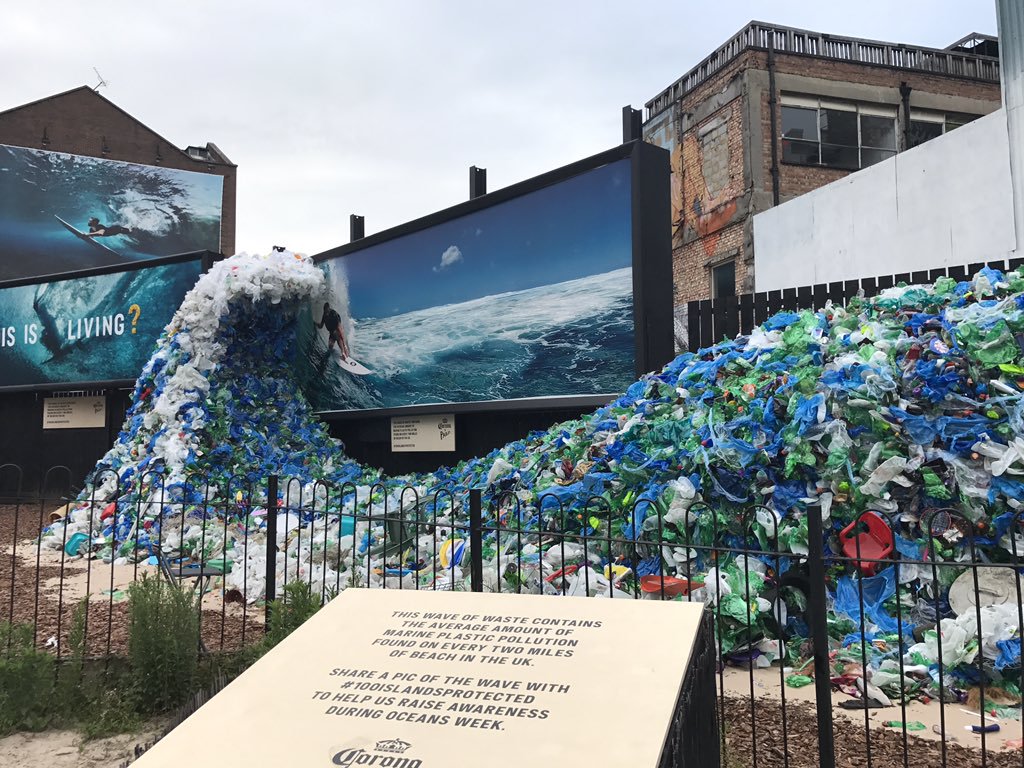
Corona plastic wave, London to mark World Oceans Day on 8th June
15. The strength and flexibility which makes plastic so useful also means that it lasts for hundreds of years in our environment. A plastic bottle will take over 450 years to break down, and when it does it will slowly disintegrate into thousands of tiny micro plastics. That means that every piece of plastic you have ever used is still in the environment today.
16. One study estimated that it would take 67 ships 1 year to clean up less than 1% of the Great Pacific Garbage Patch. That doesn’t even consider the majority of plastic which has sunk to the ocean floors.
17. It is no longer a question of if we can tolerate plastic, buthow bad it is to human health. The average person now eats around 70,000 pieces of microplastic each year. This is the equivalent to 100 bits of microplastic per meal, according to a study by the Environmental Pollution. If you think you can cleverly avoid this, you are sadly mistaken, as a team of UK-based researchers found that 14 pieces of microplastic had accumulated next to their dinner plates within just 20 minutes by placing petri dishes with sticky surfaces next to dinner plates.
18. One study found marine plastic pollution in 100% of marine turtles, 59% of whales, 40% of seabirds and 36% of seals examined.
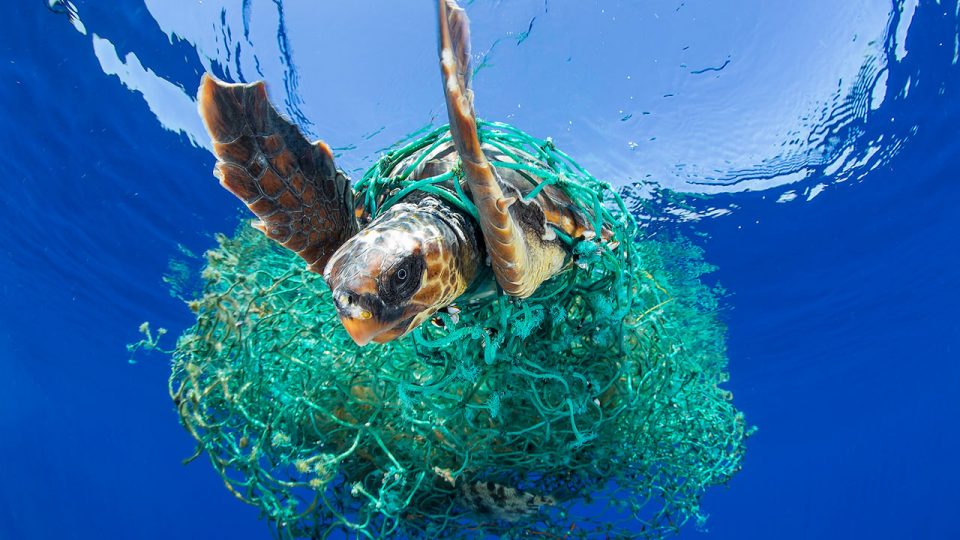
19. This is not just a problem that affects poorer countries. Approximately 5,000 items of plastic pollution have been found per mile of the beacheshere in the UK.
20. Believe it or not, over 150 plastic bottles litter each mile of the UK’s beaches.
21. The effects plastic has on marine life is devastating. Around 100,000 marine mammals and turtles are killed by plastic pollution each year, as well as 1 million sea birds.
22. By 2050, virtually ever seabird on the planet will have eaten plastic.
23. Nearly 1 million plastic bottles are sold every minute around the world. Sadly this figure is due to increase by 20% by 2050. The rate of increase is exponential, the findings showing that in 2016 more than 480 billion plastic bottles were purchased compared to 300 billion just ten years before. Of this, just 7% were recycled into new bottles, the rest ending up in landfills.

Recycled plastic bales
24. Nearly half of all plastic rubbish generated globally is due to packaging. This shows the importance to try to buy consumable goods that are plastic free. Nowadays many products are shipped direct to your door. Whether you are a small business or a customer, try to look for brands which ship products in sustainable packaging. Companies like SR Mailing who's mission is to create zero waste packaging are great brand ambassadors to follow.
26. A shocking but sadly true figure, according to Ecowatch, is that between 500 billion and 1 trillion plastic bags are used worldwide every year. A large city like New York alone uses 23 billion plastic bags annually, according to the New York City Department of Environmental Conservation. Fortunately, something is at least being done to reduce this number, as a bill has just been introduced to ban plastic grocery bags).
27. The World Economic Forumhas found that just 10 rivers across Asia and Africa carry 90% of the plastic that ends up in the oceans. 8 of these rivers are in Asia, the Yangtze, Indus, Yellow, Hai He, Ganges, Pearl, Amur, and Mekong, and two are in Africa, the Nile and the Niger. This is due to high populations living in areas with poor waste management systems.
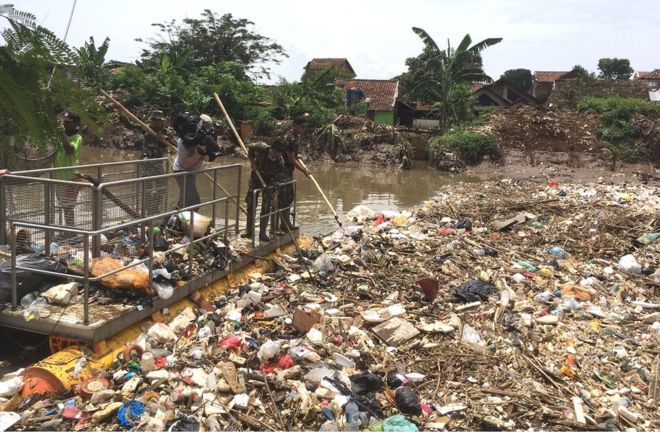
Plastic berg blocking Indonesian River - BBC
28. The average time that a plastic bag is used for is just 12 minutes. And they take up to a thousand years to decompose!
29. If you lined up the plastic thrown away each year, it would be enough to circle the earth four times.
30. Plastic production uses around 8% of the world’s oil production.
31. The plastic that does float is likely to be carried to one of 5 ocean patches. The biggest of these is the Great Pacific Garbage Patch, located between Hawaii and California. It is twice the size of Texas, or 3 times the size of France, and outnumbers sea life six to one.
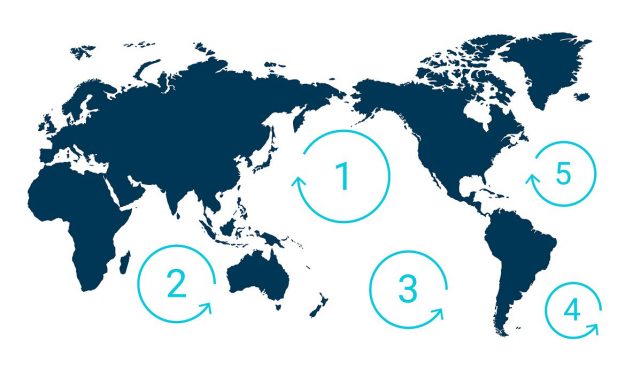
Ocean garbage patch locations
If you are feeling overwhelmed by these facts, a lot can be done to reduce your plastic consumption.
Start by trying to shop plastic free. We have put together a list of the UK’s best plastic free online shops to help you on this journey.
Admittedly this journey towards reducing your plastic waste is not easy. Read about our first steps towards plastic free supermarket shopping.
Even if you only take small steps today, you will be making a difference.
Leave a comment
Comments will be approved before showing up.